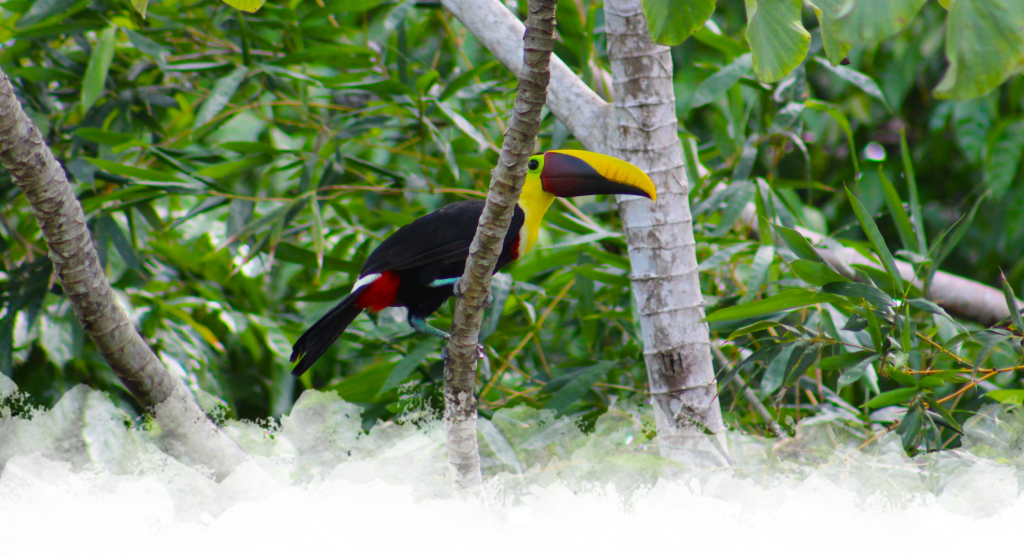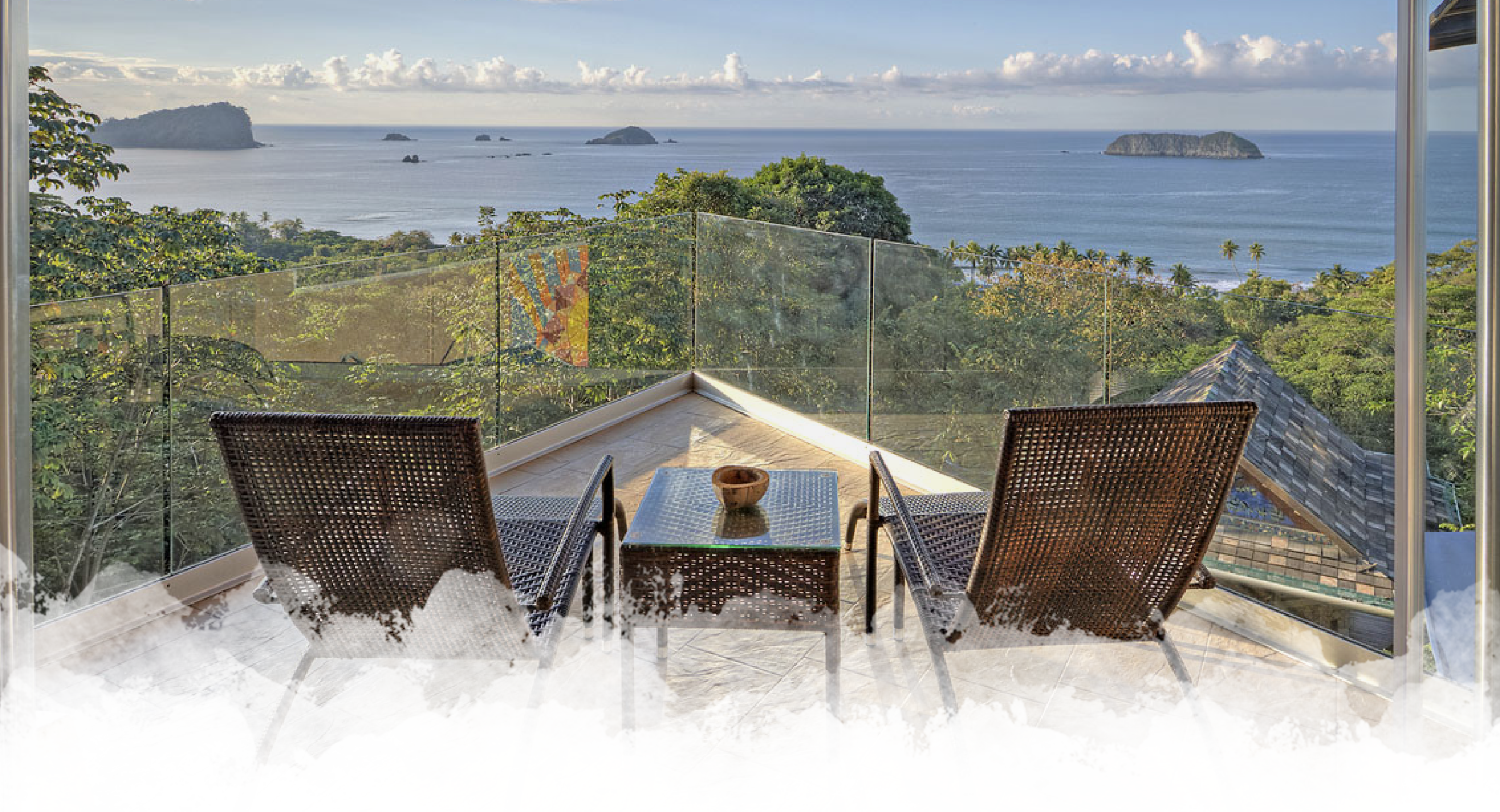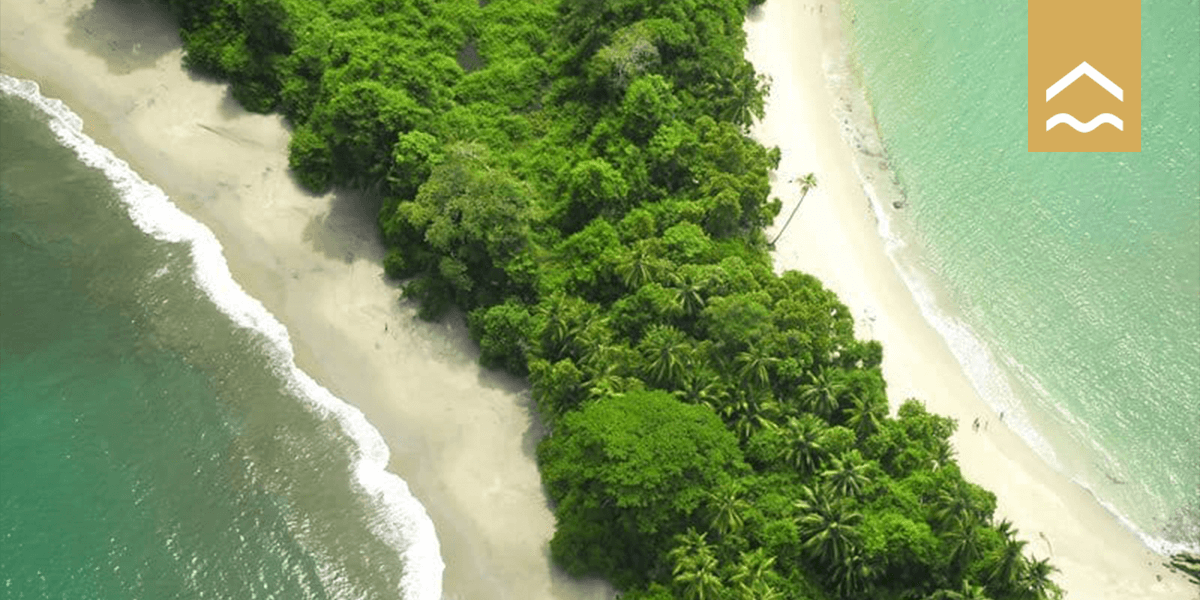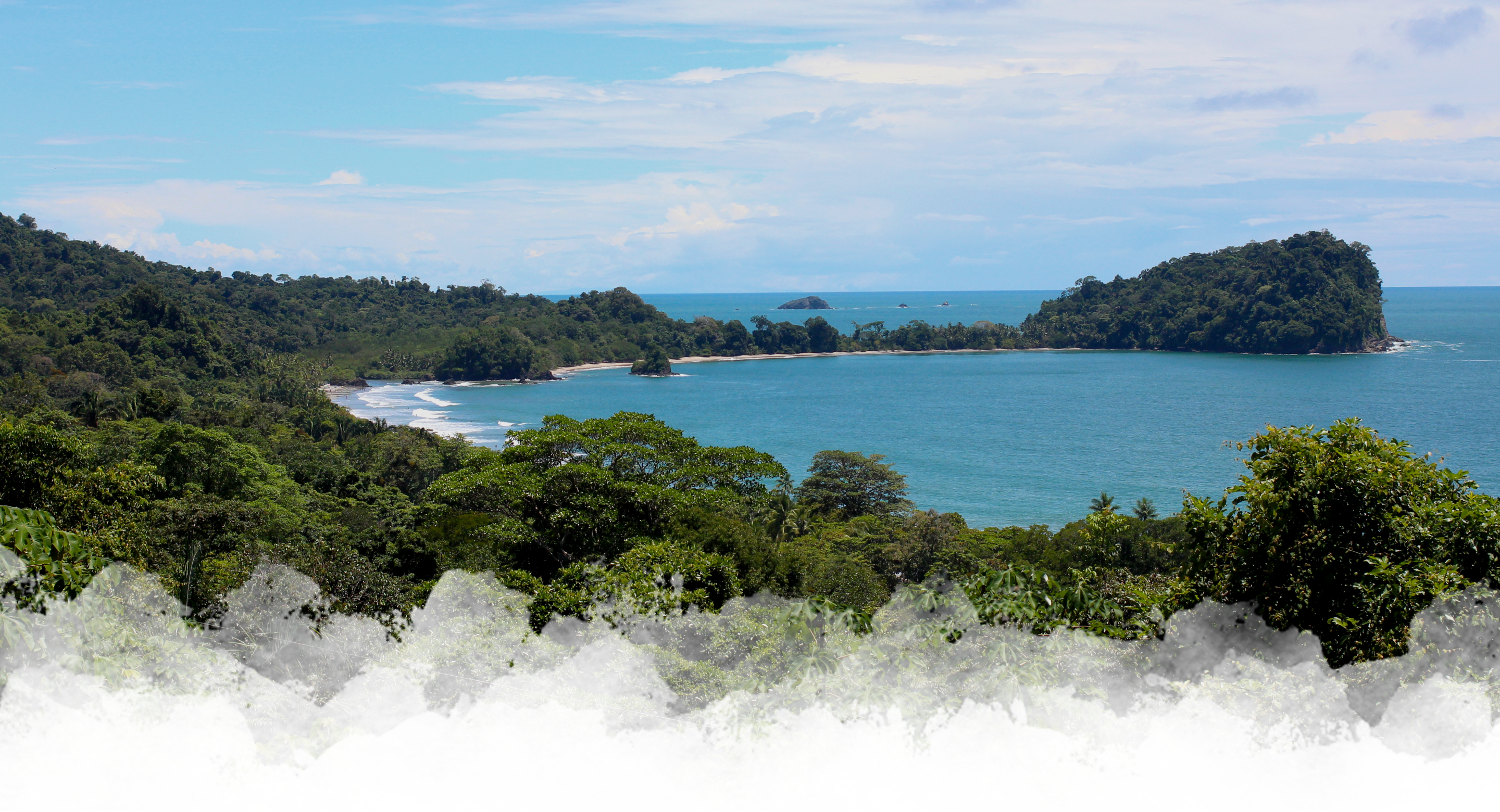Everything You Need to Know About Costa Rica
Costa Rica is the ultimate destination for adventure, relaxation, and luxury all in one. From its beautiful beaches and lush rainforests to its wildlife and eco-tourism, this small but amazing country has something for everyone. Whether you’re looking for the best time to visit Costa Rica, top places to visit, or tips for a luxury stay in Manuel Antonio, this guide with all the Costa Rica FAQs has got you covered.
Read on for insider tips on where to go, what to eat, and how to make the most of your Costa Rica vacation!
Ultimate Costa Rica Travel Guide: Table of Contents
- General Questions About Costa Rica
- Costa Rican Food
- Costa Rica Wildlide
- Traveling to Costa Rica
- Traveling to Costa Rica
- Costa Rican Currency
- Costa Rica Culture
- Costa Rica Blue Zones
- Destination Comparisons
- Why Choose Manuel Antonio
General Questions About Costa Rica
Where is Costa Rica located?
Costa Rica is located in Central America, bordered by Nicaragua to the north, Panama to the south, the Pacific Ocean to the west, and the Caribbean Sea to the east.
What is Costa Rica known for?
Costa Rica is famous for its national parks, biodiversity, ecotourism, volcanoes, stunning beaches, and adventure travel opportunities. Despite being a small country with only 0.3% of the world’s surface area, it is home to about 6% of the world’s biodiversity.
What time zone is Costa Rica in?
Costa Rica operates on Central Standard Time (CST) year-round, as it does not observe daylight savings time.
Costa Rica is the size of what state in the U.S.?
Costa Rica is roughly the same size as West Virginia, covering about 51,100 square kilometers (19,700 square miles).
What are some fun Costa Rica facts travelers should know?
What does ‘Pura Vida’ mean?
Pura Vida means “Pure Life”, and it’s more than just a phrase—it’s a way of life in Costa Rica. Locals use it as a greeting, farewell, and a general expression of positivity.
Costa Rican Food
What is the best food to eat in Costa Rica?
Costa Rican cuisine is simple yet delicious. Some must-try dishes include:
- Gallo Pinto (rice and beans, often served at breakfast)
- Casado (a typical lunch plate with rice, beans, meat, plantains, and salad)
- Ceviche (fresh seafood cured in citrus juices)
- Tamales (especially during holidays)
- Chifrijo (a popular bar snack made of rice, beans, chicharrón, and pico de gallo)
What is the best Costa Rica fruit to try?
Costa Rica has an abundance of exotic fruits, including:
- Mamon Chino (rambutan) – A tropical fruit with a hairy red shell and sweet, juicy, lychee-like flesh.
- Guanábana (soursop) – A large, spiky green fruit with creamy white pulp that has a tangy, citrusy flavor often used in smoothies and desserts.
- Cas (Costa Rican guava, often used in juices) – A small, tart fruit commonly blended into refreshing juices due to its unique sweet-sour taste.
- Maracuya (passion fruit) – A round fruit with a thick rind and aromatic, tart-sweet pulp filled with edible seeds, perfect for juices and desserts.
- Carambola (starfruit) – A crisp, juicy fruit shaped like a star when sliced, with a mildly sweet, citrus-like flavor.
Each morning at our villa in Manuel Antonio, our chef puts together a sprawling plate of fresh Costa Rican fruits from the local market for you to enjoy. Throughout your stay, you’re likely to try most, if not all, of these.
A recent guest, Rachel, who stayed with us at Villa Punto de Vista in January 2024, shared, “The mornings began each day with a delightful breakfast spread featuring fresh fruit, pancakes, eggs, bacon, sausage, pastries, and mimosas. The staff were exceptionally kind, attentive and accommodating, making us feel like family.”
Can you travel Costa Rica with food allergies?
Yes! While rural areas may have limited options, major cities and tourist areas often easily accommodate food allergies. In fact, the traditional Costa Rican diet is very gluten-free-friendly and is very easily made vegetarian, dairy-free, nut-free, and more.
Costa Rica Wildlife
What animals can you see in Costa Rica?
Costa Rica is one of the most biodiverse countries on Earth, and you’re almost guaranteed to spot wildlife during your stay—especially if you’re staying near the rainforest or national parks. Some must-see animals include:
- Sloths – Slow-moving and adorable, sloths are commonly seen in trees around Manuel Antonio and the Osa Peninsula.
- Monkeys – You’ll likely see howler monkeys, white-faced capuchins, or squirrel monkeys swinging through the canopy.
- Scarlet Macaws – These bright red, yellow, and blue parrots are stunning in flight, especially in the Osa region.
- Toucans – With their oversized colorful beaks, toucans are often heard before they’re seen.
- Iguanas – From tiny green ones to massive black spiny-tailed lizards, they love basking in the sun on rocks and rooftops.
- Tree frogs – Famous for their red eyes and vibrant green skin, these are best spotted at night or in protected sanctuaries.
This is just a small sampling. Costa Rica, while small, is home to 6% of the world’s biodiversity. So, needless to say, you’ll find a lot of natural gems during your time in the country!
When is the best time to see animals in Costa Rica?
You can see wildlife year-round, but different seasons offer unique animal encounters:
- January–April (Dry Season): Great for spotting monkeys, sloths, and birds, especially in Manuel Antonio and Guanacaste.
- July–October: Turtle nesting season on both coasts. Humpback whales also migrate off the Pacific coast, especially around Uvita and Dominical.
- May–November (Green Season): With fewer crowds and lush greenery, wildlife becomes even more active in the rainforest, especially frogs and birds.
Can you visit animal sanctuaries in Costa Rica?
Yes! Animal sanctuaries and wildlife rescue centers are a great way to see animals up close and learn about conservation. Some favorites include:
- Kids Saving the Rainforest (Manuel Antonio)
- Jaguar Rescue Center (Puerto Viejo)
- Sloth Sanctuary of Costa Rica (Cahuita)
Just be sure to visit only ethical sanctuaries that don’t allow direct animal handling and are focused on rehabilitation and release.
Traveling to Costa Rica
When should I travel to Costa Rica?
Truthfully, there’s no bad time to visit Costa Rica. Each season has its charm.
- Whale Season (September – October): See the amazing humpback whales dance against the emerald rainforest and calm shores.
- Green Season (June – August & November 1 – 15): Experience Costa Rica at its most lush, where afternoon rains bring life to waterfalls and wildlife thrives in the jungle.
- High Season (November 15 – May 31): Enjoy endless sunshine, golden beaches and adventure filled days as Costa Rica is at its driest and most beautiful.
- Holiday Season (Christmas – New Year’s): Celebrate the season in tropical paradise, where holiday cheer meets sun drenched beaches and magic.
We have an entire blog about the best time to visit Costa Rica here if you’re interested in reading more.
Are there travel restrictions to Costa Rica?
As of 2025, no major travel restrictions apply, but it’s best to check the Costa Rican tourism website for updates.
Is it safe to travel to Costa Rica?
Yes! Costa Rica is considered one of the safest countries in Latin America.
For those seeking an exclusive luxury villa in Costa Rica, Villa Punto de Vista in Manuel Antonio provides not only breathtaking ocean views but also 24/7 security and concierge services to ensure a worry-free experience in one of the safest and most beautiful destinations in Latin America.
Can you drink the tap water in Costa Rica?
Tap water is safe in most of San José, the Central Valley, and major tourist destinations, like our luxury villa in Manuel Antonio. However, it’s safer to use bottled water in rural areas and along the Caribbean coast.
In Manuel Antonio, tap water is generally safe to drink. At Villa Punto de Vista, we’ve taken it a step further with a state-of-the-art purification system, ensuring crisp, clean water at all times. Enjoy the convenience of both still and sparkling water on demand for an added touch of luxury.
Which Costa Rica airport is the best to fly into?
Costa Rica has two main international airports:
- San José (SJO): Best for access to Arenal Volcano, La Fortuna, and the Central Valley.
- Liberia (LIR): Best for Pacific coast beaches, Guanacaste, and Nicoya Peninsula.
There are also smaller airports throughout the country, like Quepos (XQP), which is close to our villa and allows travelers to arrive on 20-minute domestic charter flights rather than driving.
Where in Costa Rica to visit?
Costa Rica is a paradise for nature lovers, adventure seekers, and those looking to unwind in breathtaking surroundings. Whether you’re chasing waterfalls, relaxing on pristine beaches, or exploring lush rainforests, the country offers something for everyone.
Here are some of the best places to visit in Costa Rica:
Manuel Antonio National Park: Where Rainforest Meets the Beach
Located on Costa Rica’s Pacific Coast, Manuel Antonio National Park (right by our villa) is the perfect blend of stunning beaches and diverse wildlife.
This world-renowned destination is home to white-faced capuchin monkeys, sloths, toucans, and vibrant scarlet macaws, making it an excellent destination for eco-tourists and photographers.
Beyond the wildlife, Manuel Antonio boasts turquoise waters, soft sand beaches, and lush jungle trails, ideal for both relaxation and adventure.
Staying at a luxury villa in Manuel Antonio, such as Villa Punto de Vista, elevates your experience with breathtaking ocean views, private chef services, and world-class hospitality.
Here’s what a recent guest said so you can picture a stay for yourself:
“I don’t have the right words to express how amazing our stay was! Everything about the property is impressive – the rooms, views, pools, and location. However, the service you receive as their guest steals the show. The service was impeccable with no detail being spared, and the staff truly treats you like family. It was truly a trip of a lifetime, and thankful to have stayed here!” -Cyndi, June 2024
Arenal Volcano & La Fortuna: The Ultimate Adventure Hub
Arenal Volcano and the surrounding town of La Fortuna are a must-visit for travelers looking for hot springs, hiking trails, and stunning landscapes.
The towering Arenal Volcano provides a dramatic backdrop for activities such as zip-lining, waterfall rappelling, and whitewater rafting on the Balsa River. After a day of adventure, unwind in the region’s natural geothermal hot springs, with luxurious resorts like Tabacón Thermal Resort & Spa offering relaxing volcanic mineral pools.
Nicoya Peninsula: Costa Rica’s Blue Zone Haven
The Nicoya Peninsula, a Blue Zone where people live longer, healthier lives, is known for its pristine beaches, laid-back atmosphere, and strong wellness culture.
The coastal towns of Santa Teresa, Montezuma, and Nosara are famous for their yoga retreats, surf camps, and eco-lodges, attracting travelers seeking both adventure and relaxation. Whether you’re catching waves at Playa Guiones, enjoying farm-to-table cuisine, or exploring hidden waterfalls, the Nicoya Peninsula embodies the essence of Pura Vida living.
Osa Peninsula & Corcovado National Park: The Wild Heart of Costa Rica
For an off-the-beaten-path adventure, the Osa Peninsula and Corcovado National Park offer one of the most biodiverse ecosystems on the planet.
Home to jaguars, tapirs, scarlet macaws, and four species of monkeys, Corcovado is a wildlife enthusiast’s dream. This remote paradise is ideal for hiking, birdwatching, and immersive eco-tourism experiences. The region’s untouched beauty and rich biodiversity make it one of the most rewarding places to visit in Costa Rica for those who crave an authentic jungle adventure.
What’s the best itinerary for Costa Rica with kids?
We have full itineraries you can check out! Here is a 5-day itinerary and a 7-day itinerary.
Is it better to travel Costa Rica without a car?
It depends on your travel plans!
At Villa Punto de Vista, we recommend private transfers for stress-free travel to and from the villa. There are a few reasons for this. We think your vacation should be free of logistics and directions. Plus, once you arrive on-site, the villa has vehicles and a driver to transport you wherever you need to go. It’s not uncommon in Costa Rica for there to be road closures or detours not noted on Google Maps, and local drivers know how to maneuver around that.
Can I travel to Costa Rica without Spanish knowledge or skills?
Yes! In popular tourist areas, many locals speak basic to fluent English, especially in hotels, restaurants, and tour companies. However, knowing a few Spanish phrases can enhance your experience and help with interactions in more rural areas.
Some useful phrases include:
- “Hola” (Hello)
- “Gracias” (Thank you)
- “¿Dónde está…?” (Where is…?)
- “La cuenta, por favor” (The check, please)
- “No hablo mucho español” (I don’t speak much Spanish)
Are Costa Rica beaches nice?
Yes! Costa Rica is home to some of the most beautiful beaches in the world, featuring white, golden, and even black volcanic sand.
Most beaches are swimmable, but some have strong currents. Sometimes, swimming at low tide is better as there are smaller waves. Always check local conditions, especially on the Pacific Coast, where riptides can occur. Popular safe swimming beaches include:
- Manuel Antonio Beach – Known for calm waters and soft sand
- Conchal Beach – Known for crystal-clear waters and shell-covered shores
- Flamingo Beach – Known for snorkeling and swimming
Costa Rican Currency
Which currency does Costa Rica use?
The official currency of Costa Rica is the Costa Rican Colón.
Will Costa Rica take U.S. dollars?
Most places will take U.S. dollars when you’re traveling in Costa Rica.
What language is spoken in Costa Rica?
Spanish is the official language of Costa Rica, but many speak English as well since tourism is the main industry.
Costa Rica Culture
Are there any festivals or holidays worth planning a trip around?
Yes! Costa Rica celebrates a variety of colorful festivals that offer an amazing way to experience local culture, music, food, and community pride. If your travel dates overlap, it’s well worth joining in the fun.
Here are the top Costa Rican festivals to know:
- January – Palmares Festival
Held just outside San José, this is one of the biggest festivals in the country. Expect live music, rodeos, parades, and street food—similar to a county fair but with Latin flair. - February – Puntarenas Carnival
On the central Pacific coast, this week-long festival features Caribbean-inspired costumes, beachside parades, and nightly concerts. Great for families looking to dance and enjoy local food. - March/April – Semana Santa (Holy Week)
Costa Rica’s version of Easter is filled with processions and family gatherings. Towns may feel quieter, but beaches will be packed with locals on vacation. - July 25 – Guanacaste Day
Celebrating the annexation of Guanacaste from Nicaragua in 1824, this national holiday includes traditional music, folk dancing, ox-cart parades, and cowboy rodeos—especially lively in Liberia. - August 2 – Día de la Virgen de los Ángeles
Pilgrims from all over the country walk to Cartago to honor Costa Rica’s patron saint. Even if you don’t participate, it’s moving to witness the devotion and unity of the community. - September 15 – Independence Day
Expect student parades, marching bands, and lantern processions celebrating Costa Rica’s independence from Spain. A family favorite and fun to catch in any town. - October – Limón Carnival
This Afro-Caribbean celebration bursts with color, music, and flavor. Held in Puerto Viejo and Limón, it’s a cultural deep dive into a different rhythm of Costa Rican life.
Can tourists attend these festivals?
Absolutely! Costa Ricans (Ticos) are incredibly welcoming and love when visitors join the celebration. Just be respectful, and don’t be afraid to dance a little—it’s all part of the experience.
Should I book in advance during festivals?
Yes. Hotels and villas (especially in Manuel Antonio, Guanacaste, and Puerto Viejo) can fill up quickly during major festivals and national holidays. Book early to ensure your spot.
Costa Rica Blue Zones
Why is Costa Rica the healthiest country?
Costa Rica is one of the world’s five Blue Zones, meaning people here live longer, healthier lives. Some reasons for this include:
- A plant-based diet rich in fresh fruits, vegetables, beans, and rice.
- An active lifestyle, with many Costa Ricans walking and working outdoors.
- A strong sense of community and purpose, known as “plan de vida” (life plan).
- Clean air, access to nature, and high happiness levels.
Destination Comparisons
Costa Rica vs Brazil
Costa Rica and Brazil both have incredible biodiversity, but the travel experience is very different. Costa Rica is a small and easy-to-navigate country with a strong focus on eco-tourism, where you can explore volcanoes, cloud forests, and stunning beaches all within a short drive. Its commitment to sustainability and conservation makes it the perfect destination for nature lovers.
Brazil is a big country with wildly diverse landscapes, from the Amazon Rainforest and Pantanal wetlands to the iconic beaches of Rio de Janeiro and the thundering Iguazu Falls.
If you want a compact adventure with efficient logistics, Costa Rica is the way to go.
Costa Rica vs Honduras
Both have beautiful beaches, rainforests, and wildlife, but safety and tourism infrastructure are different.
Costa Rica is one of the safest and most developed travel destinations in Latin America, with great national parks, well-established eco-tourism, and adventure activities like zip-lining and whitewater rafting.
Honduras has stunning attractions like the Bay Islands and Copán ruins, but safety concerns in some areas make it less appealing to mainstream tourism.
Costa Rica vs Aruba
Costa Rica and Aruba have beautiful coastlines, but overall experiences are very different.
Costa Rica is a land of adventure, where you can hike through rainforests, soak in hot springs, and see wildlife like sloths and toucans. It’s an outdoor paradise for nature lovers and adrenaline junkies. Aruba is a small, dry Caribbean island, but there isn’t much beyond the resorts.
Costa Rica vs Guatemala
Both have stunning landscapes but cater to different types of travelers.
Costa Rica is for luxury adventure seekers, with national parks, volcanoes and cloud forests for endless outdoor activities.
Guatemala is for history lovers, with ancient Mayan ruins like Tikal, the colonial city of Antigua and Lake Atitlán surrounded by volcanoes.
Costa Rica vs Mexico
While both Costa Rica and Mexico have stunning landscapes, culture, and adventure, Costa Rica offers a more continuous and immersive experience in nature.
Mexico is big, and it can take a long time to get from one place to another. Costa Rica is small and easy to get around. You can experience rainforests, volcanoes, and beaches all in a few hours’ drive. Costa Rica is also a global leader in eco-tourism and conservation, and you can see wildlife in its natural habitat.
Costa Rica vs Hawaii
Costa Rica and Hawaii have volcanoes, tropical landscapes, and beautiful beaches in common, but they offer different kinds of travel experiences.
Hawaii, as part of the US, has well-developed infrastructure, high-end resorts, and unique Polynesian culture, making it a more familiar destination for American travelers. But it’s more expensive and commercialized.
Costa Rica is a more affordable and eco-conscious option, where you can explore dense rainforests, see exotic wildlife, and experience local Pura Vida hospitality.
Costa Rica vs Thailand
Both Costa Rica and Thailand have beautiful landscapes, warm hospitality, and adventure-filled experiences, but they appeal to different types of travelers.
Thailand is a budget paradise, with affordable accommodations, street food, ancient temples, and stunning islands like Phuket and Koh Phi Phi. It’s rich in history and culture with bustling cities like Bangkok offering a mix of modernity and tradition.
Costa Rica is more expensive than Thailand but offers a more compact and easy-to-navigate experience, with a focus on eco-tourism and sustainability.
Costa Rica vs Belize
Both Costa Rica and Belize have tropical beauty, but Costa Rica is the ultimate destination for adventure and biodiversity.
Belize has the barrier reef and diving spots, but lacks the variety of ecosystems found in Costa Rica.
In Costa Rica, you can wake up to howler monkeys in the jungle, hike to a volcano, relax in natural hot springs, and see sloths and toucans–all in the same trip.
Costa Rica has a well-developed infrastructure, so you can explore safely and comfortably.
Costa Rica vs Dominican Republic
Both Costa Rica and the Dominican Republic have beautiful beaches, but Costa Rica has so much more beyond the shore.
The Dominican Republic is all about all-inclusive resorts and mass tourism, while Costa Rica delivers an authentic and immersive experience.
Costa Rica also prioritizes sustainability, so tourism benefits both the environment and local communities.
Why Manuel Antonio, Costa Rica Should Be Your Next Travel Destination
Costa Rica is where rainforests, volcanoes, and golden beaches all come together in one trip. Whether you’re looking for adventure, relaxation, or a deeper connection to nature and culture, this country has it all, with the spirit of Pura Vida guiding the way.
For a luxury stay in the middle of it all, Villa Punto de Vista in Manuel Antonio offers ocean views, top-notch service, and the perfect balance of comfort and adventure. Whether you’re looking to plan a family vacation, retreat, or destination wedding, we’d love to host you. Get in touch to book today.

















